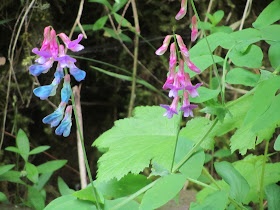I haven't done very well this month filling my coop with chickens. Back on the 12th of May I wrote that I was going to begin The Stitching Shed's "Chicken Sampler". In fact I finally started it last night. I do like the bright colors, and I'll have nine chickens for my coop when I'm done.
It's a Gray Rainy Wednesday. This week let's take a Virtual Walk.
The blossoms are spent on the Grand Hound's Tongue (Cynoglossum grande), bur that does not mean that plant is still not interesting. Take a look at the lovely seed pots that are forming.
I'm cheating as this is a scene from about a week ago. The Oregon Blue Iris (Iris tenax) have about finished up; but I like to remember the lavender swales in the otherwise green meadows that we had earlier in the month.
Side by side, an Iris and an Elegant Cat's Ear (Calochortus elegans).
Hmm...I think this is Sweet Woodruff (Galium odoratum) - it must have escaped from someone's garden.
The shrub, Cascara (Rhamnus purshiana) does not have a very showy blossom. It does, however, have pretty ridged leaves.
Along with Buttercups, the Large Leaved Avens (Geum macrophyllum) provide bright yellow accents to Spring's green.
I found this plant in the moist deep shade. It is called Siberian Miner's Lettuce (Claytonia sibirica). I've read that they are commonly used as salad greens, but I don't know of anyone who has ever eaten them.
Our native Red Columbine (Aquilegia formosa) is now in bloom. I learned at the Mount Pisgah Wildflower Festival that this columbine is dependant solely on one pollinator - the Hummingbird!
I found this plant in the deep shade. I think it is a native Trailing Blackberry (Rubus ursinus). I'll try to remember to go back later in the summer and see if there are berries.
Hairy Vetch (Vicia villosa) is native to Europe. It is used by some organic gardeners as a winter cover crop. As with all legumes it is a nitrogen-fixer.
I mentioned Buttercups, and here is the Creeping Buttercup (Ranunculus repens), a pretty non-native plant that grows in moist places.
The Northern Inside Out Flower (Vancouveria hexandra) is in full bloom in the deep shade of the forest.
And so too is the Thimbleberry (Rubus parviflorus). In the Summer it produces small red soft berries.
We only have four kinds of ferns in our area. Sword Ferns, Bracken Ferns, Licorice Ferns, and Lady Ferns. We don't have many Lady Ferns (Athyrium filix-femina) which is a shame as they have very pretty large airy fronds. I keep hoping to find some Deer Ferns or Maidenhair Ferns, but so far I've been out of luck.
And now you can see how the Corn Lily (Veratrum californicum) got its name. The plants are getting tall and soon will spout large white tassels.
I love the bright, fresh green of the new leaves on our Oregon White Oaks (Quercus garryana).
Spring time is a busy time for everyone!
I recommend that everyone take a moment or two just to look and savor all that is Spring!




















I do like those chickens. I noticed recently in M&S food section they are selling salad mixes that include flowers such as nasturtium. I don't know how popular they will be.
ReplyDeleteSuch cute chickens! Love the flowers too!
ReplyDeleteGreat colors on those chickens!
ReplyDeleteLovely walk today, Beth--even if it was gray and rainy... I'll send some of my warmth and sunshine west to you :)
ReplyDeleteThose chickens are so cute! And your pictures of nature are always so beautiful. Spring is such a lovely season.
ReplyDeleteThe chickens are going to be very colorful!! Everything is so pretty and green!
ReplyDelete